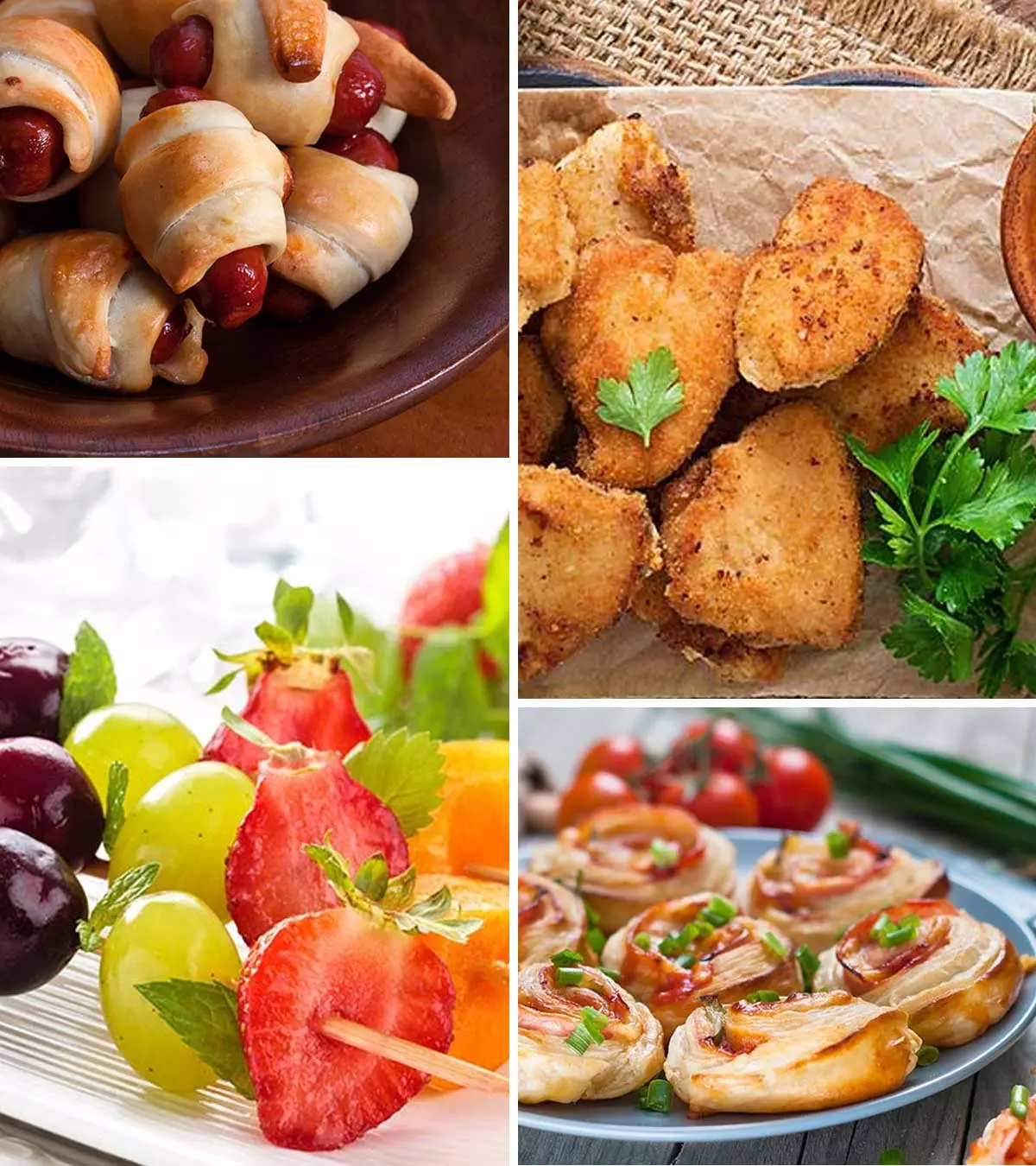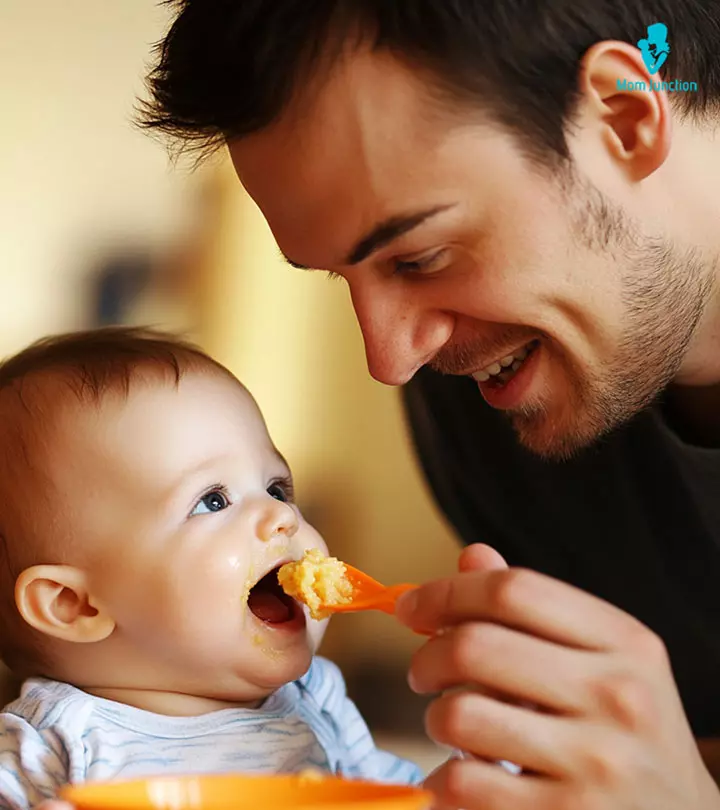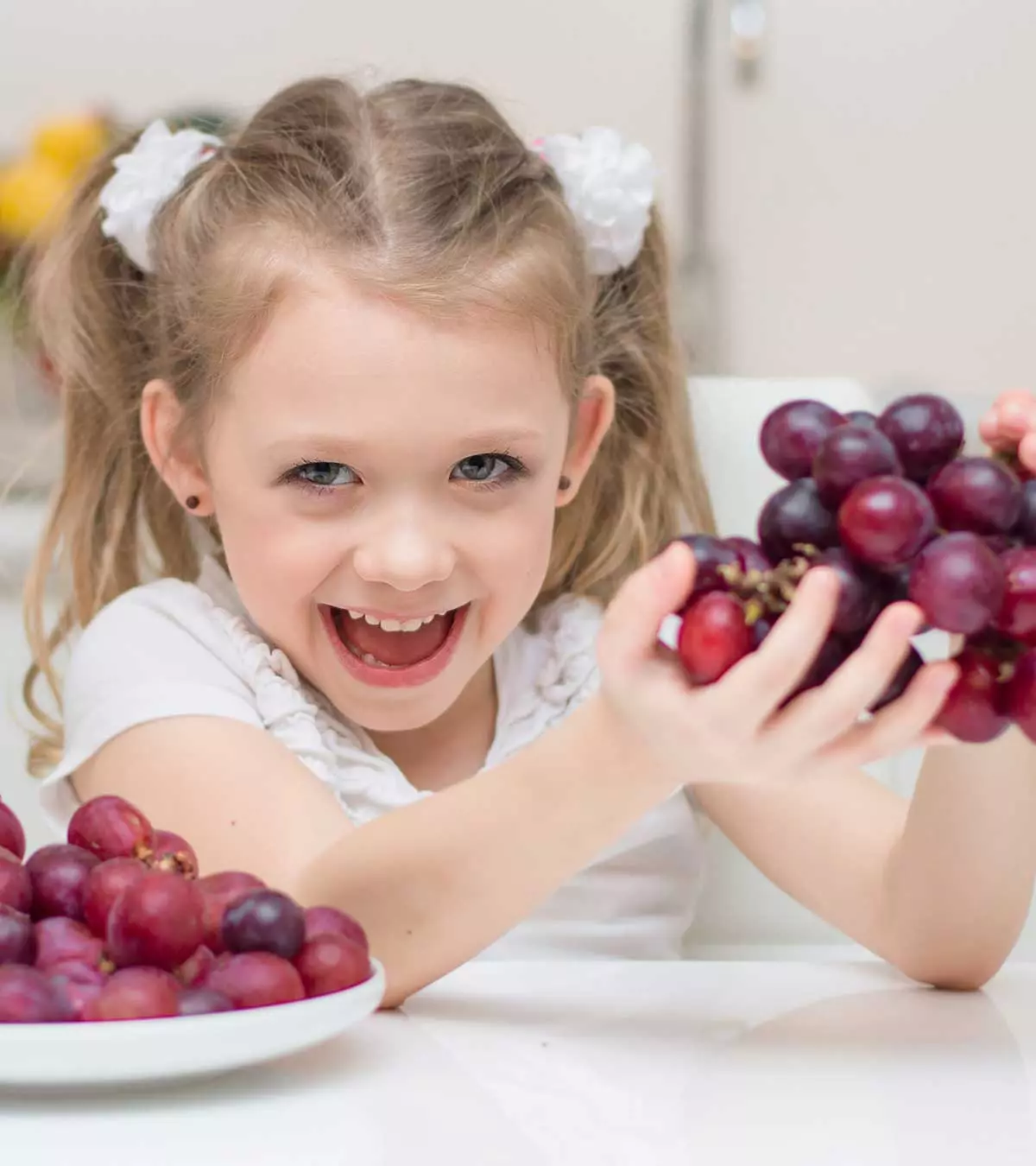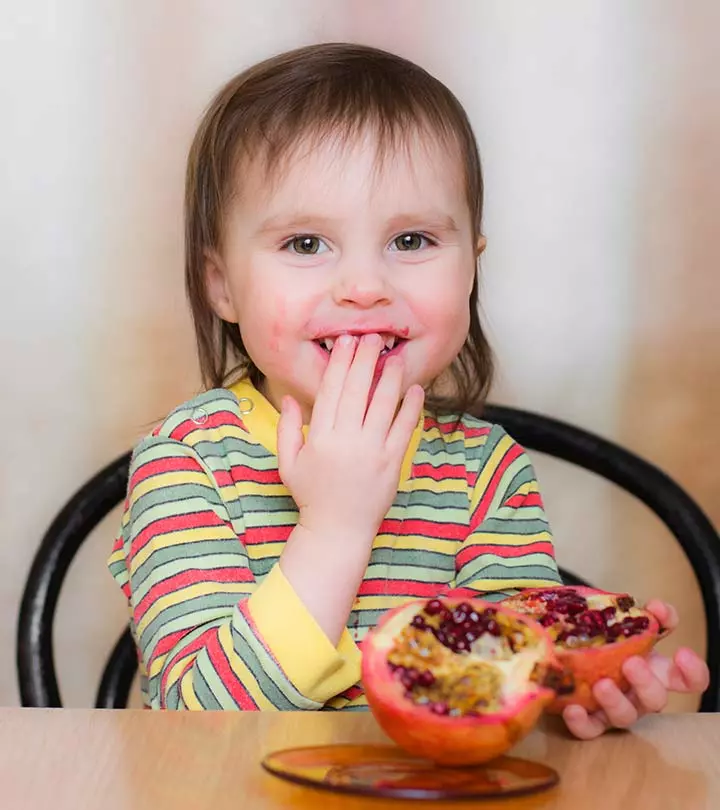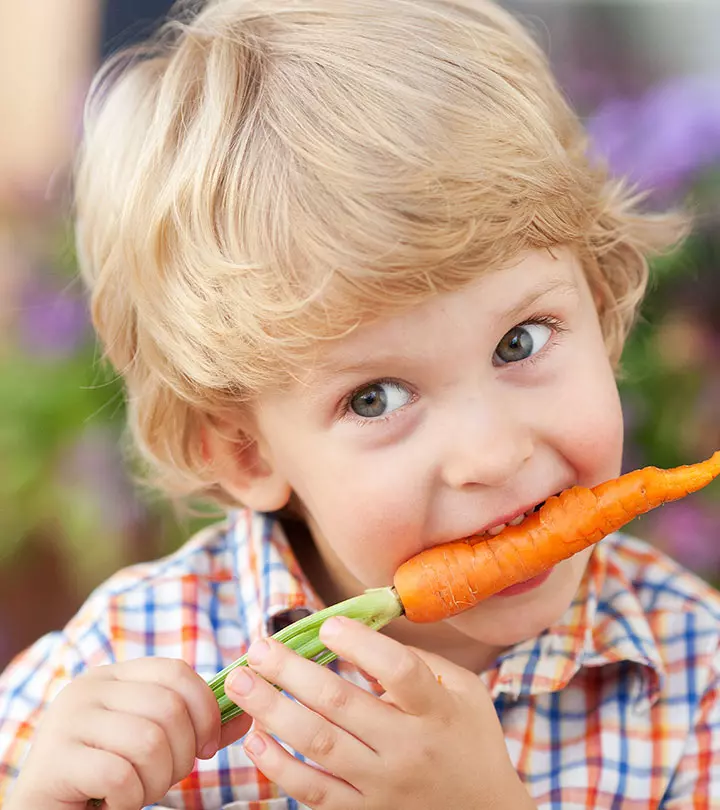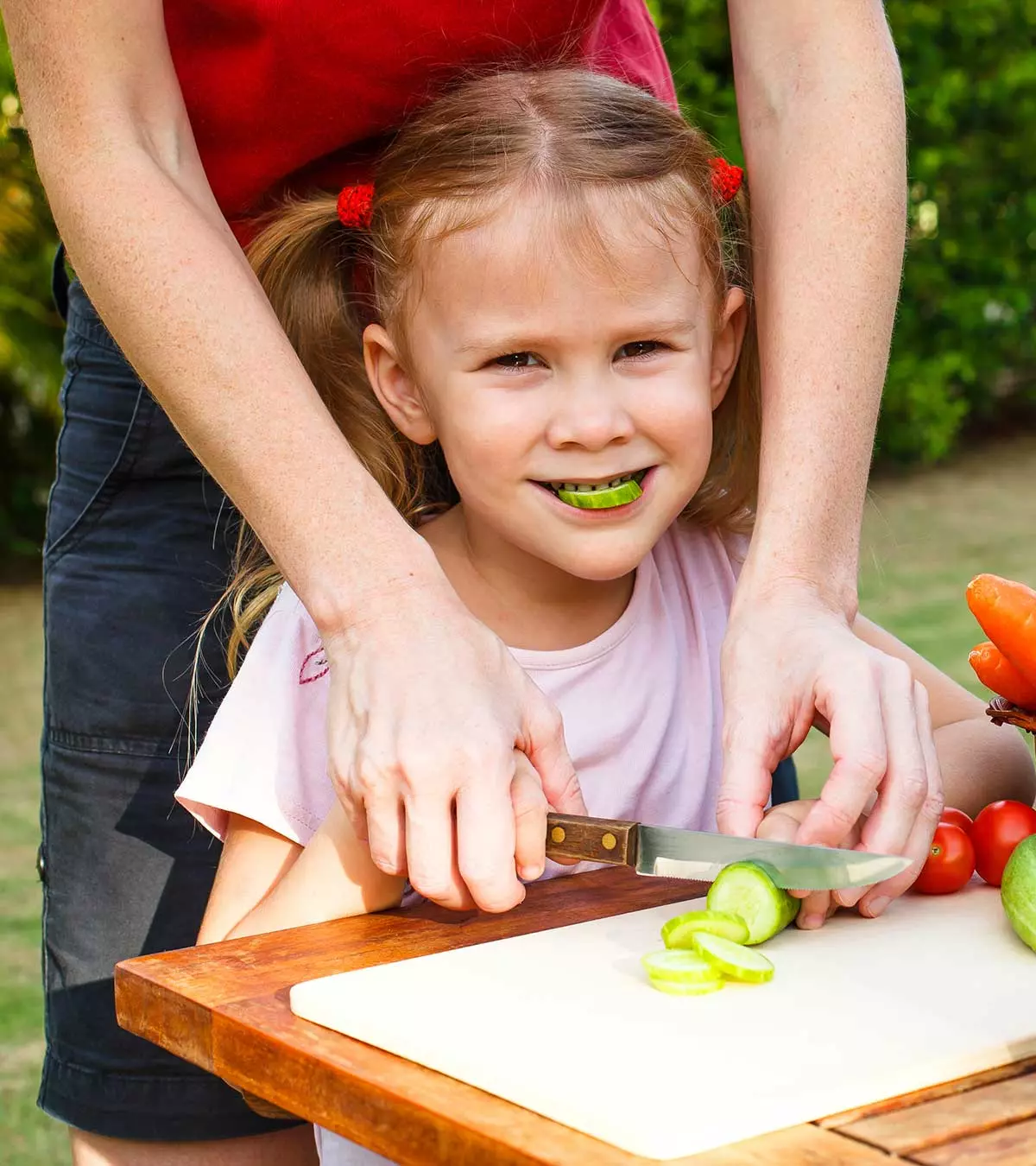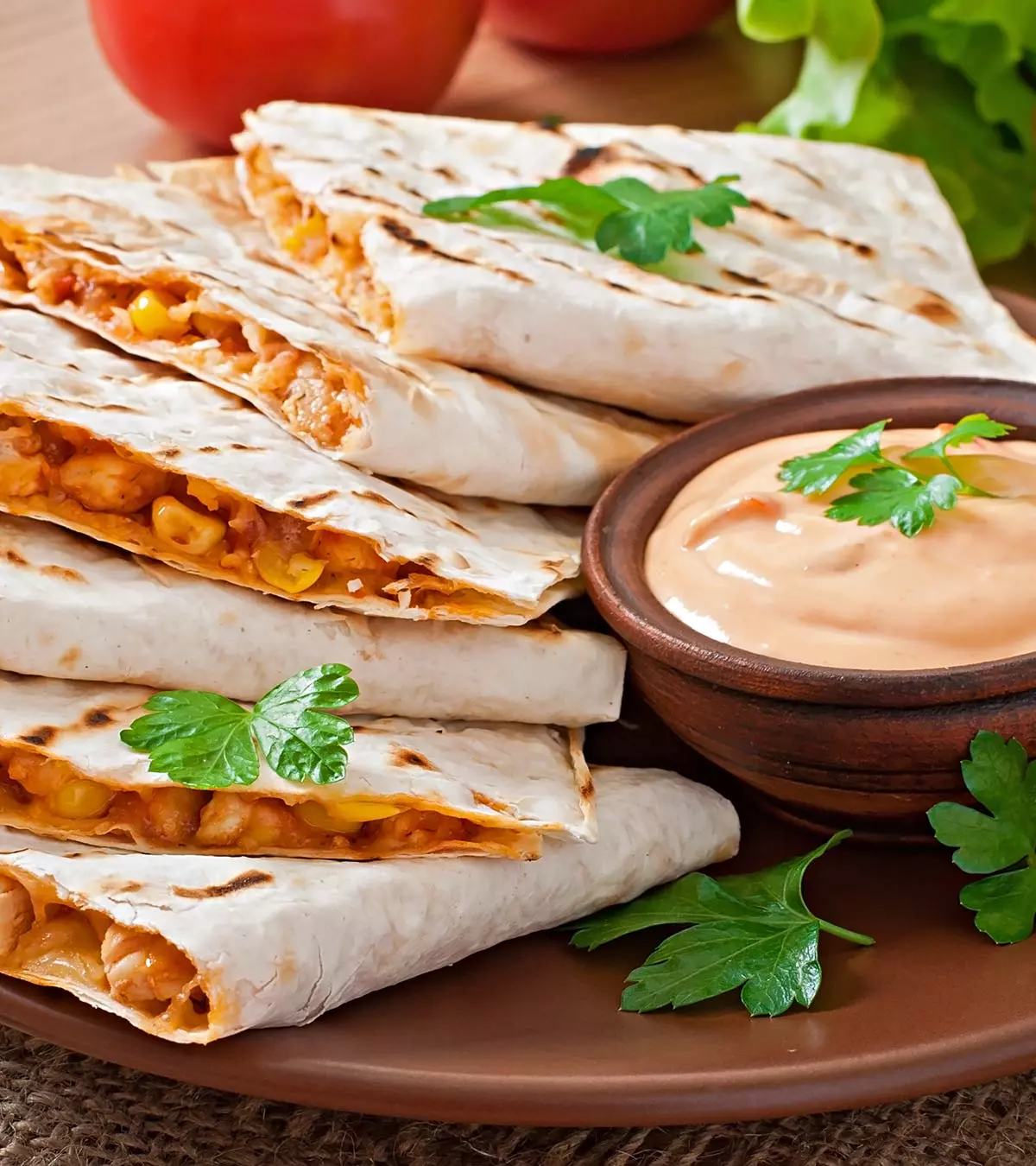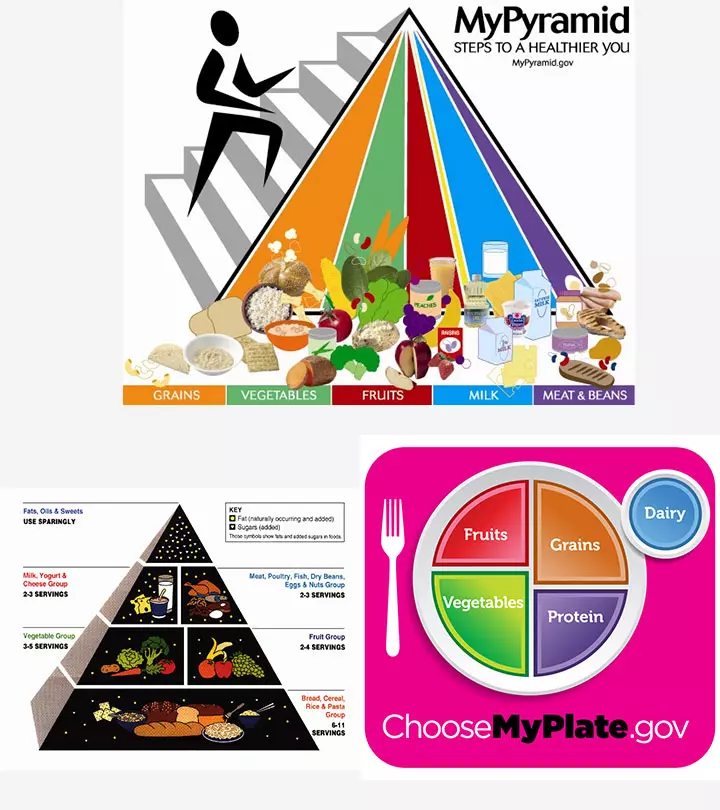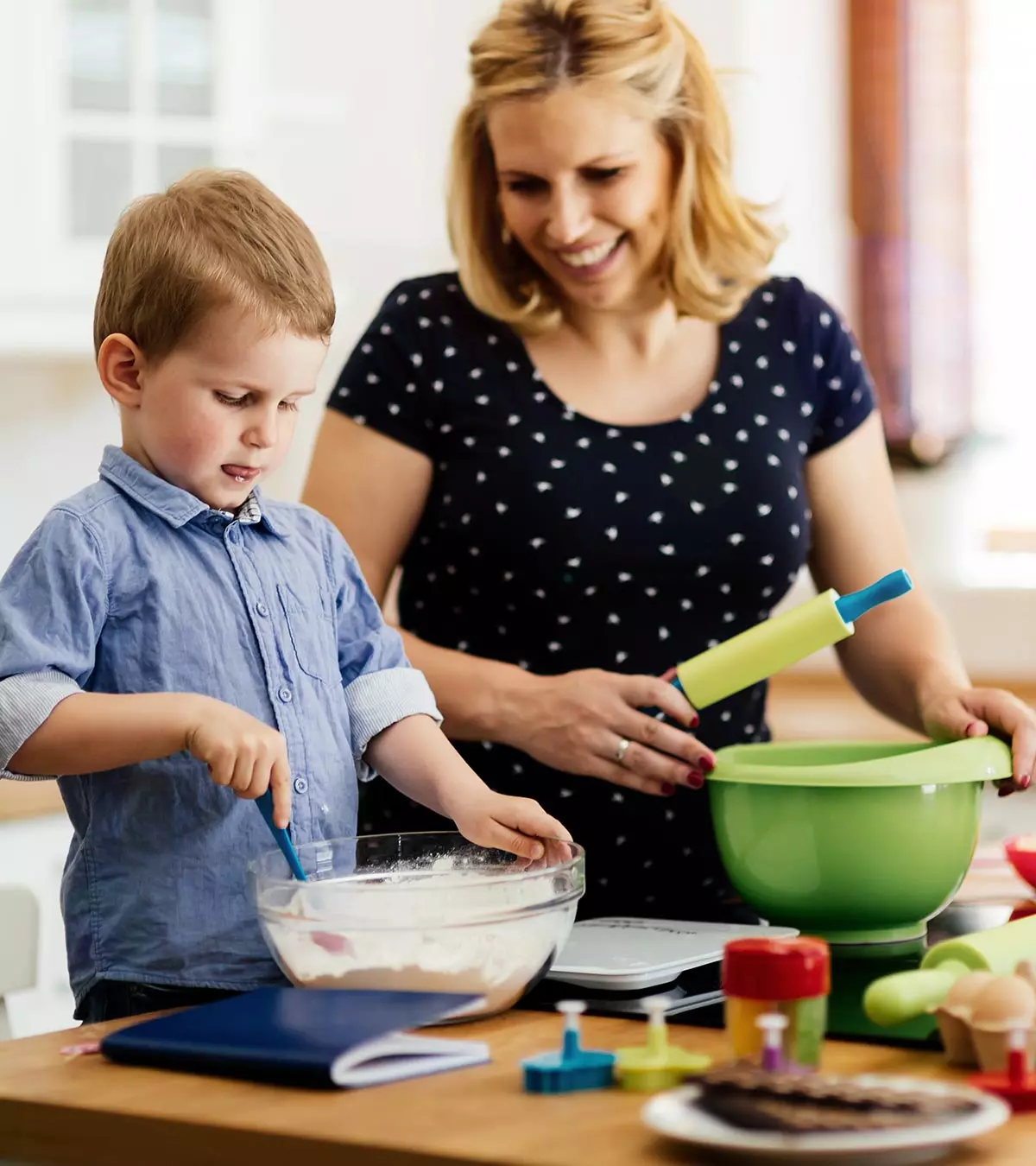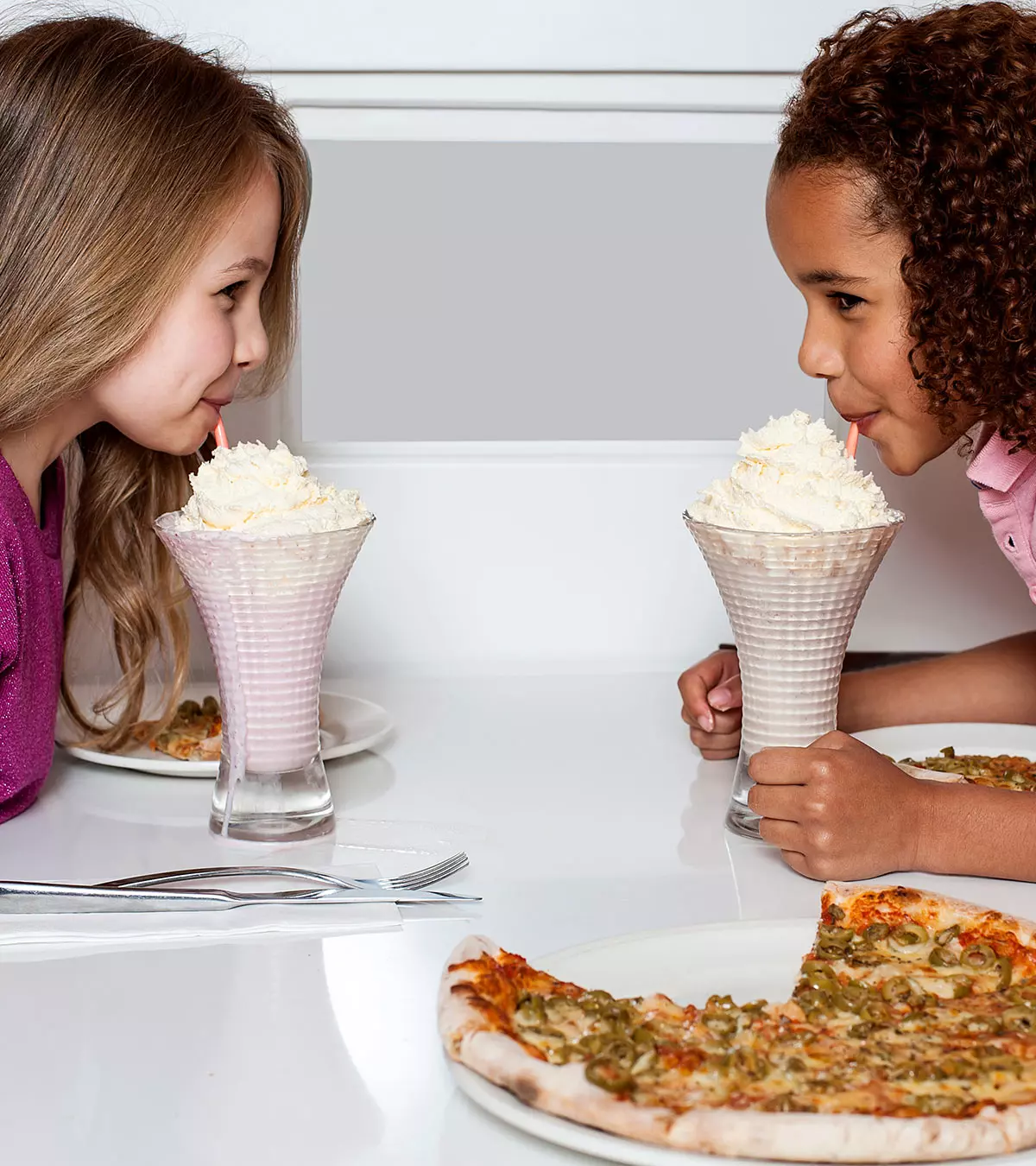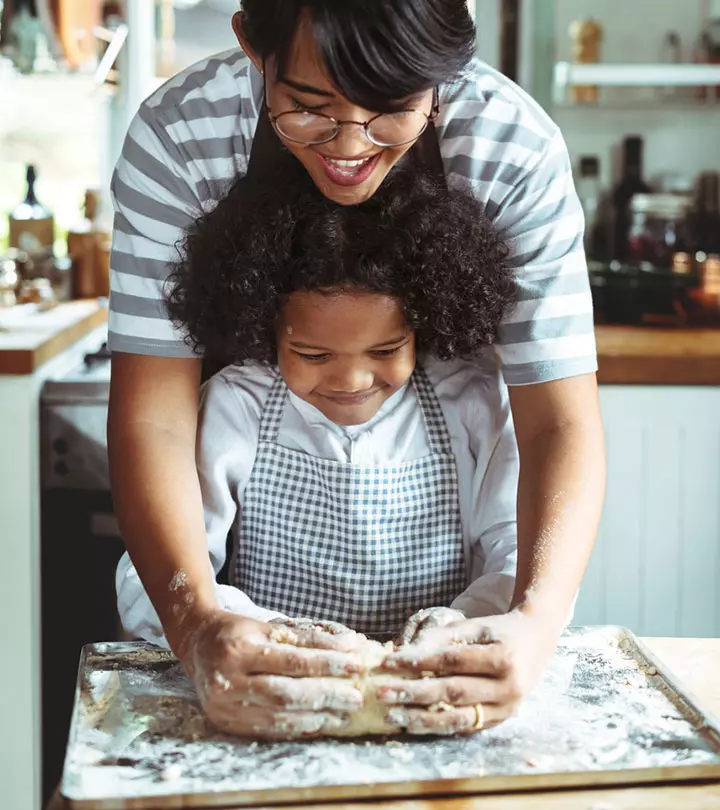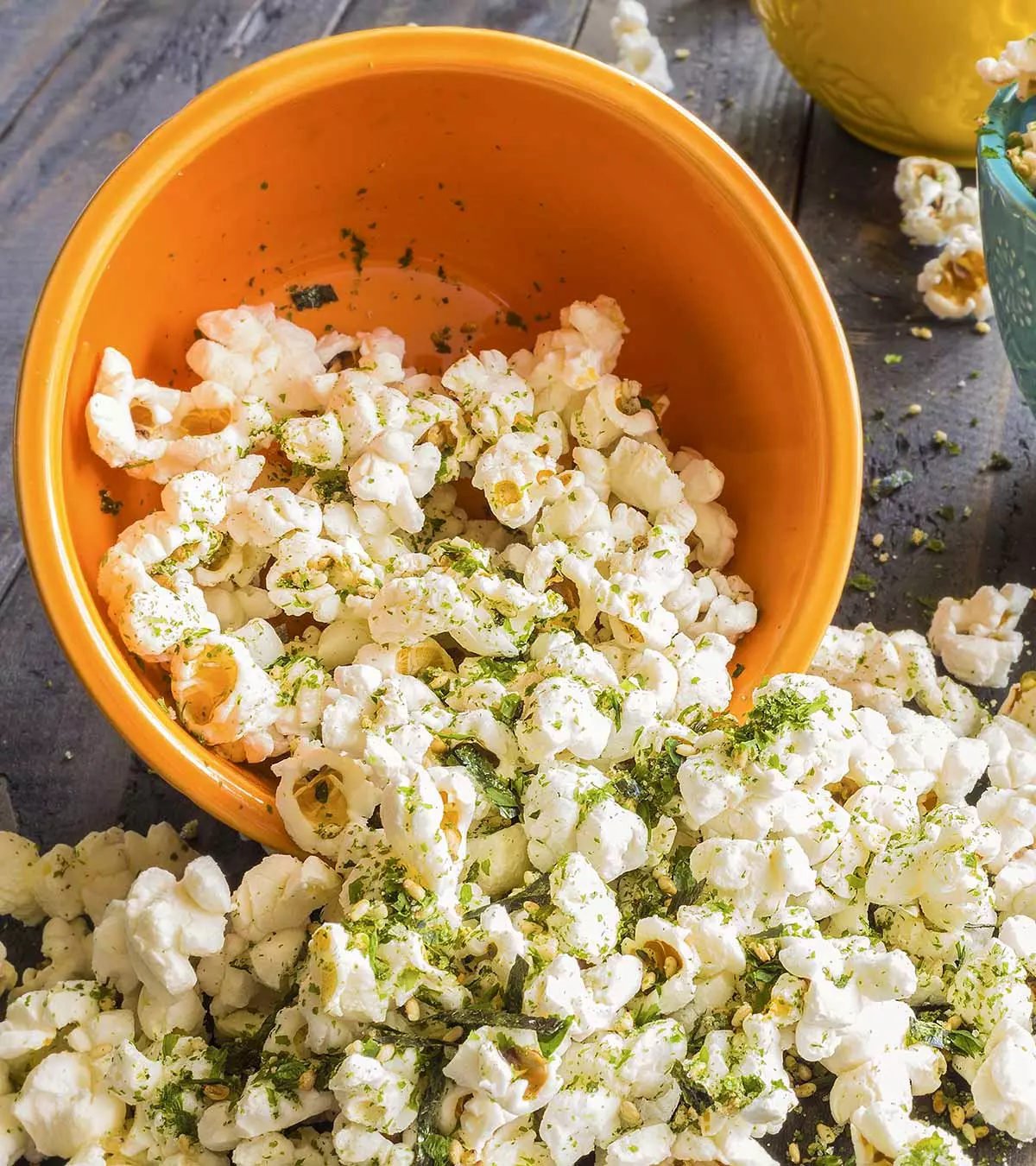
Image: Shutterstock
Cooking activities for kids can be fun and educational simultaneously. Cooking helps children relax and develop physical, social, mental, and emotional skills. For example, cooking together can help children learn the values of teamwork and communication. While cooking, they can also learn to measure, count, and cut food items. It fosters their creativity, problem-solving skills, and understanding of nutrition. Cooking also allows children to explore different textures, colors, and tastes, making it a stimulating sensory experience. These skills help children all through their lives. Moreover, the efforts they put into meal prep make them appreciate food. Picky eaters can especially benefit from cooking as they know how food comes on a plate. Cooking is ultimately a life skill, and children can learn to appreciate it. Read on as we discuss the benefits of cooking and some excellent cooking activities for children. These activities are safe for children; however, parental supervision is recommended for younger children.
Key Pointers
- Cooking involves planning, preparation, and even serving, all of which are good to be taught to your child.
- Cooking with your children allows you to bond with them while also increasing their contribution to the household.
- Cooking can also assist your child in improving their decision-making abilities and self-esteem.
- Choose a cooking activity. For instance, if your child enjoys baking, you may help them bake cakes and cookies.
Benefits Of Cooking Activities For Children
Cooking is not merely the activity of making food. It entails planning, preparation, cooking, and serving. Here are some benefits your children will reap when they cook.
1. Helps control child obesity
Children are surrounded by attractive and extremely palatable fast foods and junk foods. Cooking will help your children learn about nutrition and healthy eating. According to the 2017-2020 National Health and Nutrition Examination Survey (NHANES), the prevalence of obesity among children and adolescents aged 2-19 years was 19.7% (1). To combat this issue, it is crucial to introduce children to cooking as it can help them make healthier choices.
2. Boosts their self-esteem
Creating a new dish from scratch can give a massive boost to their self-esteem. Whenever your child feels low, indulging them in cooking can give them a good dose of self-confidence (5).
3. Increases bonding time with family
If your children are glued to their gadgets during the holidays, working on developing their culinary skills can be the perfect way to spend some quality time together. Create some beautiful memories as you cook or bake in the kitchen together.
4. Makes them more enthusiastic about eating
If your child has made something, they are more likely to be enthusiastic about eating it. The effort of creating something will give them the enthusiasm of consuming it more than if you make something and feed them. A study published in the Journal of Nutrition Education and Behavior indicates, “Children who were more involved in home meal preparation also consumed healthier diets. Encouraging parents to involve their children in meal preparation could be a viable health promotion strategy (6).”
5. Increases their contribution to family
When your children cook, they are contributing to the family. Teach your children this essential life skill early on, and as they grow a little older, you will get some time to do other chores while they cook.
6. Promotes teamwork
Cooking together in the kitchen is an excellent way for your children to learn teamwork. They will have to learn to communicate well to get work done quickly and efficiently in the kitchen.
Becca Ross, a teacher, shares her experience of cooking with her students on her blog. She says, “For the past several years of my teaching career, I have enjoyed working with my students in a cooking unit. I love to cook and bake at home with my own kids. I believe all children should grow up feeling confident in the kitchen and be given the opportunity to learn about food preparation (ⅰ).’’
7. Improves decision-making skills
Chicken or fish? Cheese sandwich or bacon? We make many decisions in the kitchen. While cooking, children will learn to make these decisions too. This will give them a sense of importance and also hone their decision-making skills.
8. Sparks imagination
Cooking is not a passive activity. It requires a lot of imagination and exploration. As they experiment with the ingredients or find creative ways to plate the dish, their creativity and imagination will be sparked.
 Did you know?
Did you know?22 Cooking Activities For Kids
These cooking activities for kids are simple, fun, and engaging.
Before you start cooking or baking with your children, make sure you
- Place all the ingredients and cooking tools at an accessible distance.
- Spread kitchen rolls or newspaper on the surface to prevent spills and stains.
- Keep washcloths handy.
You also need to remember that children need a lot of time to measure and mix things. Choose age-appropriate recipes or opt for fireless cooking for kids, and give them the freedom to spill things and experiment as much and however, they want.
 Quick tip
Quick tip1. Apple donuts
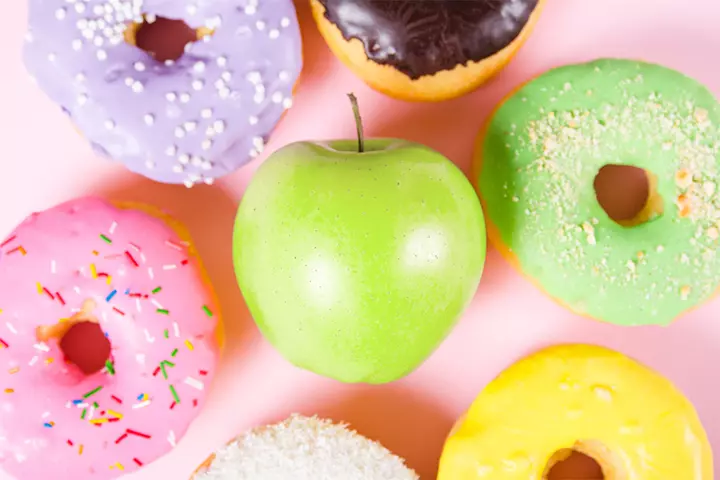
Children love donuts, and apple donuts are healthy. Make these super simple donuts and let your child decorate them as they wish.
You will need:
- Apples
- Cream cheese
- Food coloring
- Sprinkles
- Cookie cutter or knife
- Butter knife
How to make:
- Cut the apples into thin slices, around ¾” thick.
- Use the cookie cutter or knife (or an apple corer) to make a hole in the center of the slices.
- Add food coloring to the cream cheese in separate bowls and mix well.
- Apply the cream cheese to the apple slices and add the sprinkles on top.
Estimated preparation time: 15-20 minutes
Food allergy: This dish contains dairy, so avoid it if your child is allergic to dairy.
Age modifications: Younger children can assist by spreading the cream cheese, while older kids can take on the task of slicing the apples and using the cookie cutter.
2. Hedgehog rolls
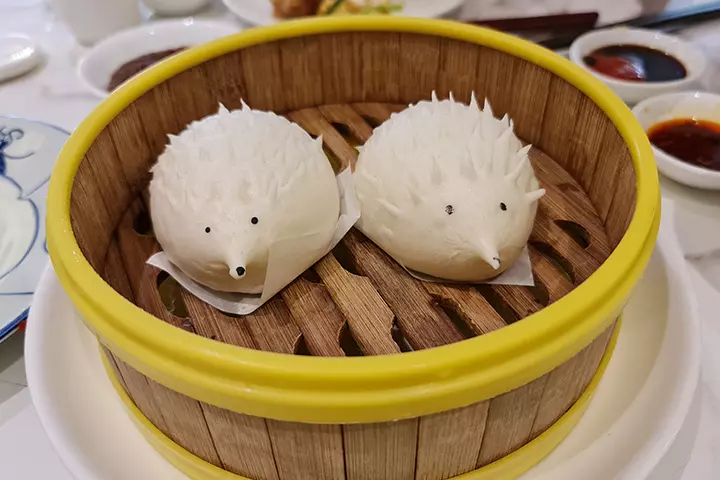
These cute hedgehog rolls are easy to make and delicious. Your children will enjoy making these and eating them too.
You will need:
- 500g brown bread mix
- Butter
- Plain flour
- Raisins
- Almonds
How to make:
- Follow the instructions on the bread mix pack to make the dough.
- Cut the dough into six pieces.
- Using flour for dusting, roll each piece into a ball and shape it into a hedgehog.
- Place the pieces on a baking sheet and cover with a damp cloth. Leave it for an hour.
- Preheat the oven to 200°C.
- Use raisins to form the eyes and almonds to form the snout.
- Bake for 15 minutes.
Estimated time: 1 hour (including dough resting time)
Food allergy: It contains almonds, so it is unsuitable for children allergic to nuts.
Age modifications: Younger kids can help by shaping the dough and adding the raisins, while older children can try baking and using the oven.
3. Applesauce

This is an evergreen recipe loved by adults and children alike. Preschool children will love making applesauce and relishing it.
You will need:
- 10 Apples
- Lemon juice
- Cinnamon
- Ground nutmeg
- Slicer and peeler
- Knife
- Measuring spoons
- Blender
- Slow cooker
How to make:
- Wash, peel, and core the apples
- Cut the apples into small pieces and add them to the slow cooker.
- Add cinnamon and nutmeg and stir.
- Add two tablespoons of lemon juice and mix well.
- Cover and cook for four hours until the apples are soft.
- Blend the mixture with a blender or potato masher, and your applesauce is ready.
Estimated time: 4 hours
Food allergy: Check for any food allergies related to cinnamon or nutmeg.
Age modifications: Younger children can stir and help add ingredients while older children peel the apples.
4. Tomato spaghetti

If your child is a pasta lover, they will love whipping up this super simple and yummy tomato spaghetti in no time. Watch them prepare and devour it in minutes.
You will need:
- Spaghetti
- Butter
- Oil
- Onion, tomato, carrot, and celery (finely chopped)
- Garlic
- Oregano
- Capers, cut in halves
- Salt and pepper
How to make:
- Heat butter and oil in a pan. Add onion and cook until it softens.
- Add carrot and celery. Crush garlic and add it as well. Fry for 2-3 minutes while stirring regularly.
- Put in chopped tomatoes, oregano, and capers. Mix well.
- Cook on medium heat for 10-12 minutes.
- Meanwhile, cook the spaghetti.
- Once done, add spaghetti to the sauce and mix well.
- Add salt and pepper according to your taste and serve.
Estimated time: 25-30 minutes
Food allergy: Be cautious of any food sensitivities, especially to garlic and onion.
Age modifications: Younger children can give a hand in stirring and mixing, while older ones can try chopping vegetables and handling the stove.
5. Christmas crispy treats

Why wait until Christmas to make this delicious dessert? You can make it any day of the year and decorate it the way you want.
You will need:
- Unsalted butter
- Crispy rice cereal
- Marshmallows
- Candy canes
- Decorations – sprinkles, M&Ms, icing gel, etc.
- Baking sheet
- Waxed paper or parchment paper
How to make:
- Melt the butter and marshmallows in a saucepan over medium heat.
- Once the marshmallows melt completely, remove the saucepan and pour in the rice cereal. Mix well so that the butter and marshmallow mixture coats the cereal evenly.
- Line the baking sheet with waxed paper and spread the rice cereal mixture on it evenly. The thickness should be around ½” to ¾”.
- Spray cooking spray on a sharp knife and cut the rice cereal in triangles or whichever shape you wish.
- Break candy canes into three-inch pieces and insert one into each crispy rice treat piece.
- Let the cereal cool completely before decorating it.
Estimated time: 20-30 minutes
Food allergy: The child should not be allergic to ingredients present in the marshmallows and candies.
Age modifications: Younger children can help mix the ingredients and decorate, while older kids can handle cutting and baking.
6. Fairy cakes

This is one of the easiest cake recipes. You can make a dozen within half an hour and see them disappear even faster.
You will need:
For the cake:
- 100g softened butter
- 100g caster sugar
- 2 eggs
- 100g self-raising flour
- 1tsp baking powder
For the icing:
- Icing sugar
- Warm water
- Decorations
How to make:
- Preheat the oven to 200°C and line a bun tin with cake cases.
- Put the ingredients into a large bowl. Whisk them well until the mixture is smooth.
- Fill the cake cases and place them in the oven. Bake for 15-20 minutes, until golden brown.
- Remove the cakes and cool.
- For the icing, pour icing sugar into a bowl and add two-three tablespoons of warm water.
- Whisk well.
- Spread over the cakes and decorate.
Estimated time: 30-40 minutes
Food allergy: This item contains eggs, butter, and flour. The child should not be allergic to eggs, dairy, or gluten.
Age modifications: Younger children can give a hand in the mixing and decoration, while older children can measure and bake the cakes.
7. Easy vegetable soup
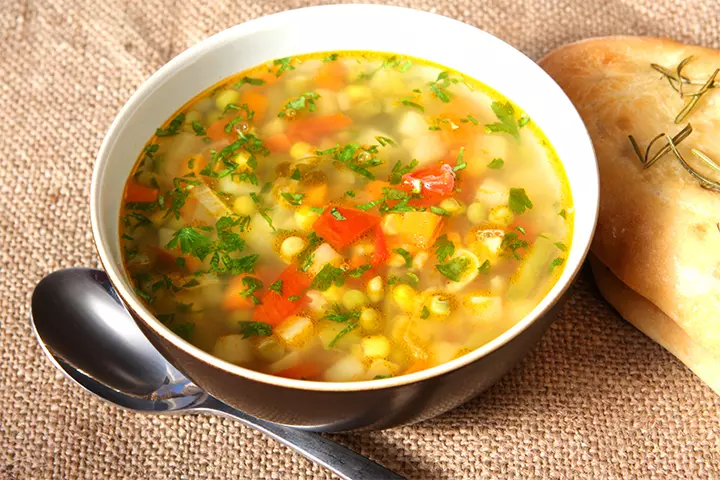
If your children are not very fond of eating vegetables, this recipe is an excellent way to acquaint them with different veggies. Who knows, your children might even gobble up the soup in seconds. Besides, this is an excellent activity for developing your child’s fine motor skills.
You will need:
- Onions
- Potatoes
- Celery
- Carrots
- Tomatoes
- Salt, pepper, garlic, and oregano
- Slow cooker
How to make:
- Ask your child to chop up all the vegetables as finely as they can. This is a great exercise for your children to develop their fine motor skills.
- Add the spices to the slow cooker.
- Stir occasionally.
- When the vegetables are cooked, and the soup gives off a delicious aroma, you can serve it.
Estimated time: 1-2 hours
Food allergy: Ensure children do not have any vegetable or spice allergies.
Age modifications: Let the younger children wash the vegetables and stir the soup, while older children can try chopping the vegetables and handling the cooker.
8. Mini pumpkin pies
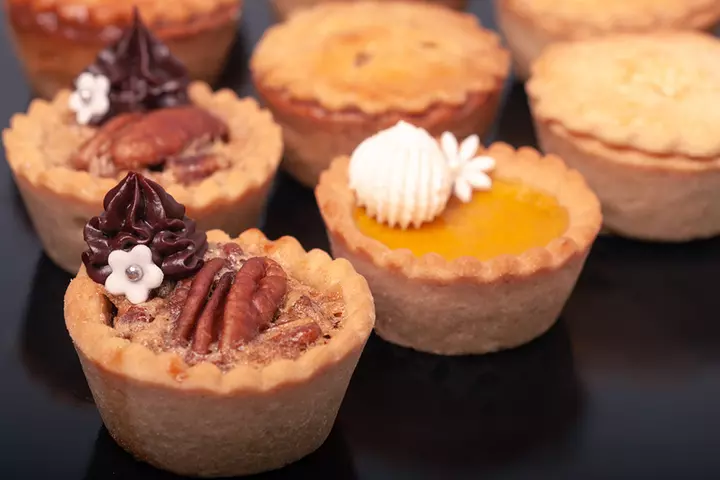
Halloween or no Halloween, pumpkin is a vegetable that children love. Maybe it is because of its sweet taste or unusual color. You can hardly go wrong with pumpkin. Make these mini pumpkin pies with your children and enjoy.
You will need:
For the pie crust:
- 300g all-purpose flour
- 1tsp salt
- 90g unsalted butter
- 150g chilled vegetable shortening
- 120ml ice water
For the filling:
- 285g pumpkin puree
- 150g brown sugar
- 120ml heavy cream
- 60ml whole milk
- 1 large egg
- ¼tsp salt
- 1tsp ground cinnamon
How to make:
- Make the crust by mixing flour and salt in a large bowl.
- Add butter and shortening.
- Use two forks to cut the butter and add it to the flour. Mix well until you get a coarse mixture.
- Add ice water and mix with a spatula.
- Transfer the dough to the work surface dusted with flour. The dough should come together easily and should not be sticky.
- Fold the dough, divide into two halves, and roll each half into one-inch-thick disks.
- Wrap tightly in plastic and refrigerate for at least two hours.
- In a mixing bowl, take pumpkin, brown sugar, heavy cream, milk, egg, salt, and cinnamon and blend well. Refrigerate.
- Preheat the oven to 190°C.
- Grease the muffin pans.
- Remove the dough from the fridge and place it on the work surface dusted with flour.
- Roll the dough into a large circle. Using a cookie cutter, cut out rounds from the dough.
- Place the dough into the muffin pans and press the dough flat to the bottom and sides.
- Add the filling in equal quantities in all the cups.
- Bake for 20-25 minutes. The center should be set, and the edges should be light brown.
- Remove the pies and let them cool for five minutes before removing them from the pan. Cool and serve.
Estimated time: 2 hours
Food allergy: Children should not be allergic to nuts, cinnamon, or dairy.
Age modifications: Allow the younger children to mix the mixture and fill the muffin pans, while the older ones can assist with rolling out the dough and baking.
9. Thai green turkey meatballs
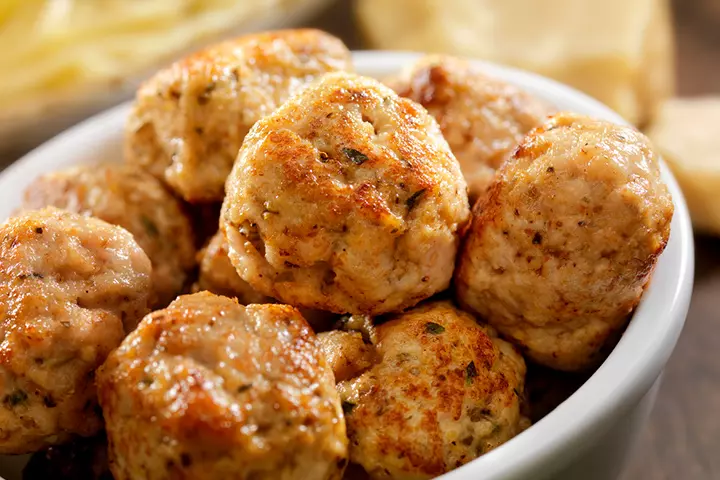
If your child watches CBeebies’ “I Can Cook,” they might have come across this amazing recipe. Try it with them.
You will need:
- 75g minced turkey
- 90g breadcrumbs
- 2 eggs
- 1tsp Thai green curry paste
- 2tsp plain flour
How to make:
- Preheat the oven to 180°C.
- In a large bowl, add one egg and beat it. Add 30g of minced turkey, 30g of breadcrumbs, and Thai green curry paste and mix well.
- Take another bowl and beat the other egg in it. Sprinkle flour and the remaining breadcrumbs on separate plates.
- Divide the meat mixture into small balls.
- Roll each meatball in flour, dip it in the egg, and roll in breadcrumbs.
- Place on a baking tray and bake for 15-20 minutes.
- Serve with a dipping sauce of your child’s choice.
Estimated time: 20-30 minutes
Food allergy: Children should not be allergic to turkey, eggs, or spices like curry paste.
Age modifications: Younger children can help shape the meatballs, while older children can handle the oven and help with the dipping process.
10. Pumpkin pie in a cup
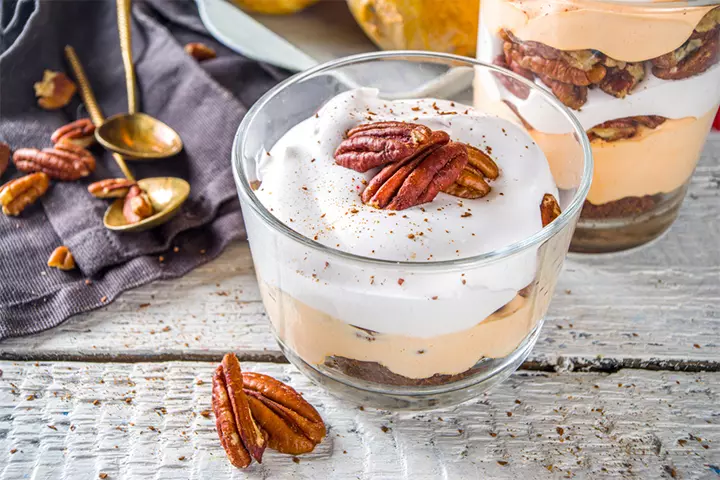
Now that you have made a pumpkin pie, this will be a breeze for your children to make. You can whip this up within minutes using the leftover pie.
You will need:
- Vanilla pudding
- Graham crackers
- Pumpkin pie mix
- Whipped cream
- Cinnamon
How to make:
- Crush the graham crackers and add them to the bottom of a clear cup.
- Scoop vanilla pudding and add it on top of the crackers.
- Add pumpkin pie on top of the pudding.
- Top it up with whipped cream and sprinkle some cinnamon.
Estimated time: 10-15 minutes
Food allergy: Avoid in case of any food sensitivities related to dairy or cinnamon.
Age modifications: Younger children can layer ingredients, while older children can assist with crushing the graham crackers and adding the toppings.
11. Bread in a bag
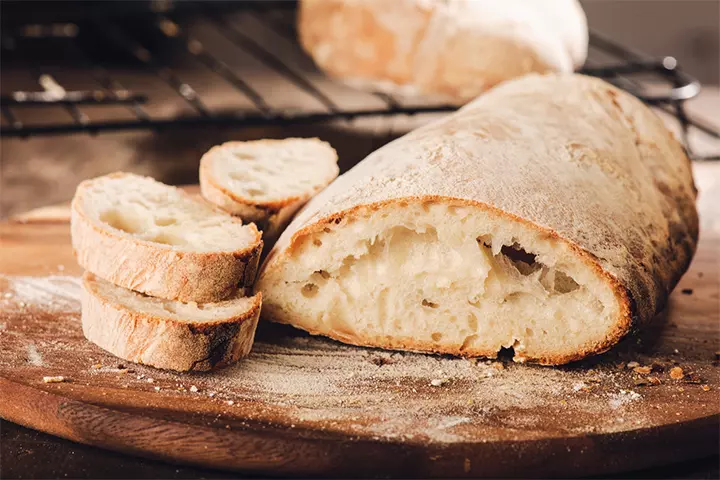
Making bread is an exercise in patience for children. It is also an excellent activity for teaching them measurements and sequences.
You will need:
- 3 cups all-purpose flour
- 2tbsp white sugar
- 2¼tsp rapid rise yeast
- 1 cup warm water
- 3tbsp olive oil or vegetable oil
- 1½tsp salt
How to make:
- In a Ziploc bag, pour one cup of flour, sugar, and yeast. Add warm water.
- Make sure all extra air is out of the bag and seal and knead well.
- Let it rest for ten minutes. You will notice bubbles.
- Open the bag and add oil, salt, and a cup of flour.
- Seal the bag again and knead until they are combined well.
- Repeat the procedure for the last cup of dough.
- Remove the dough from the bag and place it on a work surface dusted with flour.
- Knead for 10-15 minutes until the dough is smooth.
- Cover with a towel and allow to rise for half an hour.
- Divide the dough and bake for 25-30 minutes.
Estimated time: 1 hour 30 minutes
Food allergy: Contains gluten and may contain dairy if using butter.
Age modifications: Younger children can help with kneading the dough and sealing the bags, while older children can follow the instructions for mixing, kneading, and observing the dough rise.
12. Ice cream in a bag

Ice cream on a hot summer day sounds lovely. Children will enjoy making this simple recipe and will be rewarded with delicious homemade ice cream. What else could they ask for?
You will need:
- 2 Ziploc bags – one big and one small
- ½ cup half and half milk
- 1tbsp sugar
- ½tsp vanilla
- 1/3 cup rock salt
- Ice
How to make:
- Fill the bigger bag halfway with crushed ice.
- Add milk, sugar, and vanilla to the smaller bag. Seal the bag and shake well to combine all the ingredients.
- Open the bag and reseal it after removing as much air as possible.
- Sprinkle rock salt on the crushed ice.
- Place the smaller bag into the large bag and seal.
- Shake both the bags until the ice cream begins to set.
- Remove the smaller bag from the bigger one and open it. Your ice cream is ready to eat.
Estimated time: 10-15 minutes
Food allergy: It contains dairy, so it may not be suitable for a child with dairy sensitivity.
Age modifications: Younger children help shake the bag under your supervision, while older children can measure and mix the ingredients.
 Quick tip
Quick tip13. Kool-Aid candy dots

Do you need a no-bake recipe to keep your children busy for some time? This Kool-Aid candy dot recipe is just what you and your children need on a hot afternoon.
You will need:
- Wax paper
- 1½ cups powdered sugar
- 1 egg
- ¼tsp Kool-Aid flavoring
How to make:
- In a large bowl, whip the egg white and the powdered sugar together for 4-5 minutes.
- Separate the mixture and add different Kool-Aid flavors in each.
- Transfer each colored mixture into a plastic baggie or a piping cone.
- Cut the wax paper into two-inch-wide strips.
- Cut a small piece off the end of the baggies and make dots on the wax paper.
- Let the candies harden overnight. They can be eaten when not fully hardened too.
Estimated time: 10 minutes preparation, overnight drying
Food allergy: Not suitable for children allergic to eggs and artificial food coloring.
Age modifications: Younger children can choose the colors, while older kids can pipe the dots onto wax paper.
14. Rainbow fruit salad

Introduce your child to the wonders of different fruits by making a fruit salad. Let them cut, peel, and de-seed different fruits for an immersive sensory experience.
You will need:
- Fruits of different colors
How to make:
- Cut different fruits and de-seed them.
- Chop them into small pieces.
- Take a small bowl, put all the fruits in it, and serve.
Estimated time: 10 minutes
Food allergy: It contains berries, so it may not be suitable for children with certain food sensitivities.
Age modifications: Younger children can sort the fruits, while older children can peel and chop the fruits.
15. Rainbow toast
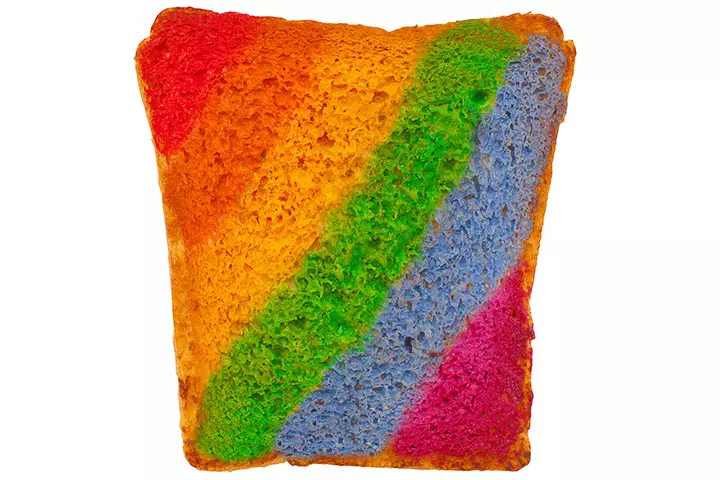
Children are fond of rainbows and toast. So why not combine them to make some rainbow toasts? They will love making and eating them.
You will need:
- Bread
- Milk
- Food color
- Paintbrushes
- Toaster
How to make:
- Pour milk into small bowls.
- Add different food colors into the bowls.
- Using new and clean paintbrushes, paint different colors on the bread slices.
- Toast and enjoy.
Estimated time: 10 minutes
Food allergy: This item may not be suitable for children sensitive to dairy and artificial food coloring.
Age modifications: Younger children can help with painting the bread, while older children can toast and serve the dish.
16. Veggie pizza rolls
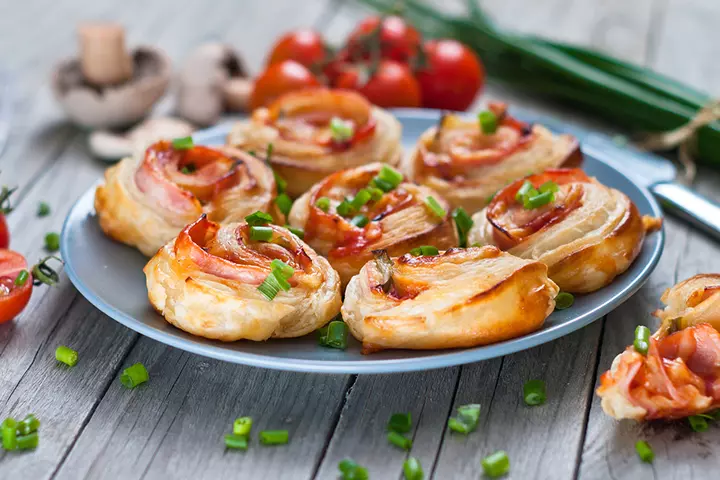
If you are worried about your child not eating enough vegetables, try this recipe. They will enjoy making these rolls and gobble them up in no time.
You will need:
- Mixed veggies
- 1 sheet of puff pastry
- Tomato pizza sauce
- Grated cheddar cheese
- 1 egg
- Oregano
How to make:
- Preheat the oven to 200°C.
- Spread tomato pizza sauce liberally on the sheet of puff pastry.
- Add mixed veggies and cheese on top.
- Roll the pastry tightly.
- Cut into smaller pieces and arrange them on a baking tray.
- Brush each roll with egg wash, sprinkle oregano, and bake for 15 minutes.
- Cool to room temperature and serve.
Estimated time: 20 minutes
Food allergy: Children with dairy, gluten, or egg allergy must avoid this food item.
Age modifications: Younger children can help by sprinkling cheese, while older children can roll and cut pastry with guidance.
17. Fruit barbeque
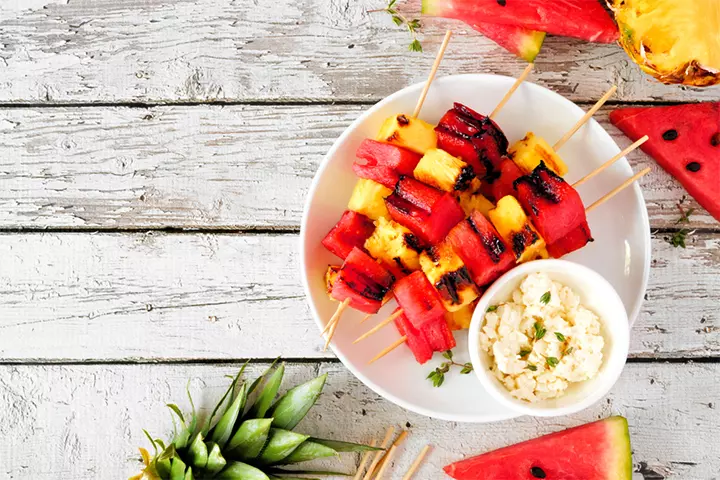
What is more exciting than eating barbecued fruit? This is another great way to let your children taste all fruits and enjoy their textures.
You will need:
- Long toothpicks
- Different fruits
How to make:
- Cut different fruits in different ways and skewer them on the toothpick.
- Serve.
Estimated time: 10 minutes
Food allergy: Children with certain food sensitivities can avoid this dish.
Age modifications: Younger children can try threading the fruits onto sticks, while older children can cut fruit under supervision.
18. Candy necklaces

Edible jewelry is the next level of indulgence for children. This no-cook, no-bake recipe is perfect for a colorful afternoon.
You will need:
- Froot Loops, pretzels, or Life Savers Gummies
- Thick nylon cord
How to make:
- Cut a length of the cord and tie a knot at one end.
- Insert various candies from the other end.
- When done, tie up the other end. Your edible candy necklace is ready.
Estimated time: 10 minutes
Food allergy: Children with gluten sensitivity and an allergy to artificial food coloring should avoid this dish.
Age modifications: Younger children can try threading the cereal pieces onto the strings, while older children can help create patterns.
19. Pretty cookies

After cakes, if there is something children love baking, it is cookies. Mixing and baking is often a calming activity for children. Your children can enjoy decorating these cookies as well.
You will need:
- 280g all-purpose flour
- 100g caster sugar
- 100g unsalted butter
- 1 egg
- 1tsp vanilla extract
- 250g icing sugar
- Food coloring
- Warm water
How to make:
- Preheat the oven to 190°C and line a baking sheet with parchment.
- Beat butter and sugar together until fluffy. Add in egg and vanilla extract and beat well.
- Add flour gradually and knead the mixture to make a dough. Do not knead for too long or make it too hard.
- Dust some flour on a work surface and roll out the dough.
- Use cookie cutters to cut out the dough into different cute shapes.
- Transfer them to the baking sheet and bake for 10-12 minutes until golden brown.
- Remove from the oven and let cool.
- In a bowl, mix the sugar with 2-3tsp warm water to make the icing. Pour it into different cups and add food coloring.
- Let the children decorate the cool cookies as they wish.
Estimated time: 30 minutes preparation, 10-12 minutes baking
Food allergy: Children allergic to dairy, gluten, egg, or artificial food coloring should avoid this.
Age modifications: Younger children can help mix and decorate the dough, while older children can roll and cut the dough.
20. Mini quiches
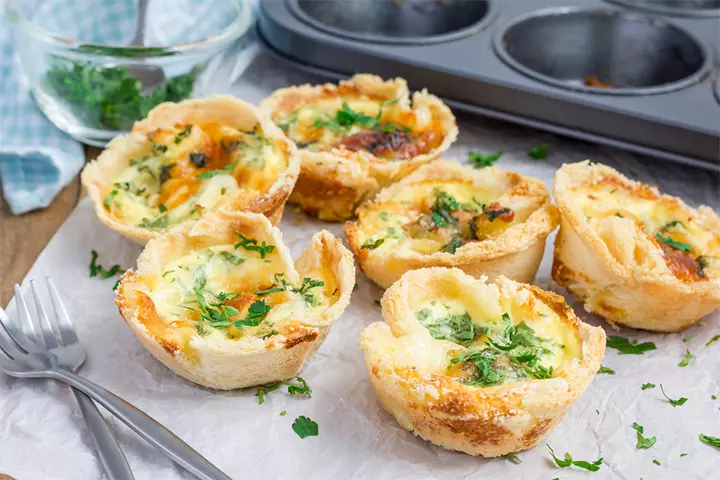
Tortilla wraps are highly versatile and great for experimenting. Children can make these quick mini quiches that are tasty and healthy.
You will need:
- Tortilla wraps
- Eggs
- Chopped vegetables
- Cherry tomatoes
- Salami
How to make:
- Preheat the oven to 180°C.
- Cut the tortilla wraps into smaller circles. Line these circles in a muffin tin, making sure the base and the sides are pressed.
- Beat the eggs and pour them into the cases. Add some vegetables, salami, and cherry tomatoes.
- Bake for 15 minutes or until the egg sets.
- Remove, cool, and serve.
Estimated time: 20 minutes preparation, 15 minutes baking
Food allergy: Children allergic to dairy, gluten, or eggs can avoid this food item.
Age modifications: Younger children can help add toppings, while older children can crack and whisk the eggs.
21. Choco bananas
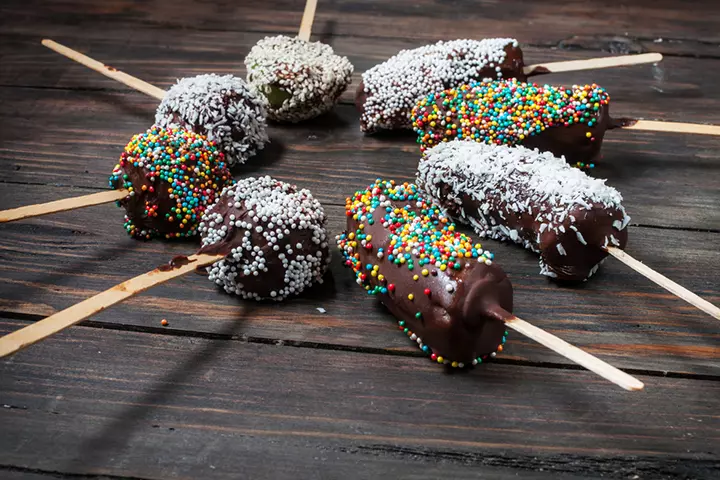
Let children go bananas with this all-time favorite snack. Chocolate and bananas taste heavenly together, and children will have something healthy.
You will need:
- Bananas
- Chocolate
- Wooden sticks
- Decorations
How to make:
- Break the chocolate into smaller pieces.
- Place a bowl with water on the stove and place another bowl with the chocolate on top of the first bowl. Ensure the bowl doesn’t touch the water beneath.
- Peel the bananas and cut them in half.
- Insert the wooden sticks into the banana halves.
- Hold the pieces using the wooden sticks and dip them in the melted chocolate. Rotate them so that all parts of each banana are coated.
- Let the excess chocolate drip back into the bowl and then place them on a plate.
- Sprinkle toppings on them and freeze.
- Allow them to sit for 15-20 minutes at room temperature before serving.
Estimated time: 10 minutes preparation, 20 minutes freezing
Food allergy: Children allergic to dairy or nuts should avoid this dish.
Age modifications: Younger children can dip the bananas into the chocolate, while older children can help melt the chocolate.
22. Scrambled eggs
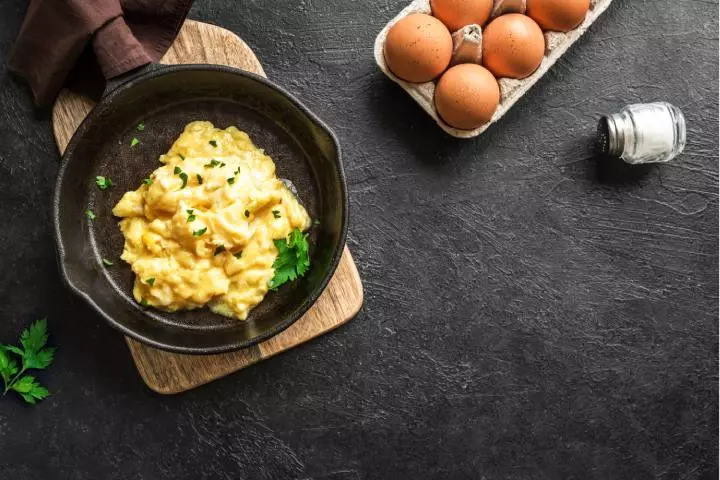
Scrambled eggs are one of the easiest, quickest yet healthful recipes to teach your children. So, by using minimal ingredients, help your children make this appetizing, creamy, and flavorful protein-packed dish.
You will need:
- 3-4 eggs
- 1 tsp milk or water (optional)
- Butter or olive oil
- Salt and pepper
- Chopped chives for garnishing
How to make:
1. Crack open eggs in a bowl and add milk or water to make it more creamy.
2. Whisk the egg mix well until it smoothens and no longer has egg whites.
3. Add a pinch of salt and pepper to taste.
4. Put a non-stick pan over a low flame.
5. Add olive oil or butter and bring the flame to medium heat.
6. Pour the egg mix into the pan and let it cook for a few seconds without stirring.
7. Continue cooking on medium-low heat and use a rubber spatula to fold, swirl, and scramble the eggs until small curds form.
8. Take the pan off the heat when the eggs appear cooked but slightly runny in places. Do not let the eggs dry in the pan.
9. Leave the eggs in the hot pan for a few seconds for carryover cooking.
10. Serve it on a plate, garnished with some chives, if you like, and enjoy.
Estimated time: 10 minutes
Food allergy: Avoid this dish if allergic to dairy or eggs.
Age modifications: Younger children can whisk the eggs under supervision, while older children can mix and serve the dish.
Safety Measures To Take While Cooking
There is no doubt that cooking is a fun and educational experience for children. However, safety should always be a priority in cooking. While handling sharp utensils or working with the cooking stove, children can get injured if not supervised at all times. Here are some safety measures to follow when cooking with children.
- Complete supervision: Adult supervision is the most important part of cooking with children. At no point should the children be left alone near heat, sharp tools, or electrical appliances. Also, ensure to assign age-appropriate tasks to prevent accidents.
- Child-friendly utensils: If possible, try to work with utensils that are meant to be handled by children. You can use plastic or dull-edged knives to cut soft foods and measuring spoons and cups designed for small hands.
- Sharp object safety. Before you start cooking, tell your child to avoid touching the knife or show them how to hold the knife safely. Teach them how to cut away from the body to avoid injuries.
- Electrical object safety: Keep electrical cords away from water and heat sources. Tell your children to never insert fingers or objects into mixers, blenders, or toasters. Unplug appliances that are not being used.
- Fire safety: Keep a fire extinguisher handy at all times. Also, show your children how to stop, drop, and roll in case of fire. Ensure inflammable materials like paper towels and dishcloths are kept away from stoves.
Frequently Asked Questions
1. What are some seasonal cooking activities for children?
There are many fun seasonal cooking activities for children. In the spring, they can help plant and care for a garden and enjoy harvesting and cooking fresh fruits and vegetables. Summer is great for grilling outdoors; children can help with everything from preparing the food to operating the grill. Fall is ideal for working on baking recipes for kids, which allows them to lend a hand with measuring, stirring, and decorating. Finally, winter is for cozy comfort foods; children can help with everything from making soup to decorating cookies.
2. What recipes are best for children to make?
Children’s favorite recipes include chocolate chip cookies, pancakes, and brownies. These recipes are relatively simple and require a few ingredients. Plus, they’re delicious.
3. What age is appropriate to start cooking activities with children?
Some experts suggest that children as young as three or four can begin helping out in the kitchen, while others recommend starting around seven or eight. Ultimately, it depends on the child’s maturity level and interest in learning how to cook (4).
4. Which baking activities are suitable for children?
Several baking activities are suitable for children, including simple tasks such as measuring ingredients, stirring mixtures, and decorating cakes. Complex activities, such as shaping dough and baking pies, can also be enjoyable for them.
5. What are some safety tips to follow when cooking with kids?
When cooking with children, keep the following tips in mind.
• Always supervise children in the kitchen.
• Teach them about kitchen utensils and tools and proper handling.
• Ensure they wash their hands before cooking.
• Keep them away from sharp objects, and use child-friendly tools.
• Keep them away from direct heat to prevent burns.
Infographic: Precautions To Take When Cooking With Children
Cooking activities are great for children to become interested in this helpful skill while staying away from junk food. But you must know the extent to which they should be involved and how to maintain safety. So here are the measures to take to avoid unfortunate incidents and keep things fun. Illustration: Momjunction Design Team
Illustration: Easy And Fun Cooking Activities For Kids

Image: Stable Diffusion/MomJunction Design Team
Personal Experience: Source
MomJunction articles include first-hand experiences to provide you with better insights through real-life narratives. Here are the sources of personal accounts referenced in this article.
ⅰ. Cooking in kindergarten.https://hilltopkindergartenkids.blogspot.com/p/cooking-in-kindergaten.html
References
- Bryan Stierman et al.; (2021); National Health and Nutrition Examination Survey 2017–March 2020 Prepandemic Data Files — Development of Files and Prevalence Estimates for Selected Health Outcomes.
https://www.cdc.gov/nchs/data/nhsr/nhsr158-508.pdf - Cooking With Preschoolers.
https://kidshealth.org/en/parents/cooking-preschool.html - Tips for Cooking with Children.
https://food.unl.edu/food-fun-young-children/tips-cooking-children// - Cooking at Every Age Why Kids Should Learn To Cook
https://www.sdchefsfoundation.org/blog/cooking-at-every-age-why-kids-should-learn-to-cook - Activities for Home & in the Community.
https://occupationaltherapy.com.au/the-benefits-of-cooking-with-your-child/ - Yen Li Chu et al. (2014); Involvement in Meal Preparation at Home Is Associated With Better Diet Quality Among Canadian Children;
https://www.jneb.org/article/S1499-4046(13)00681-7/abstract
Community Experiences
Join the conversation and become a part of our nurturing community! Share your stories, experiences, and insights to connect with fellow parents.
Read full bio of Shivani Sikri
Read full bio of Nisha Bharatan
Read full bio of Dr. Ritika Shah
Read full bio of Nida Shaikh






